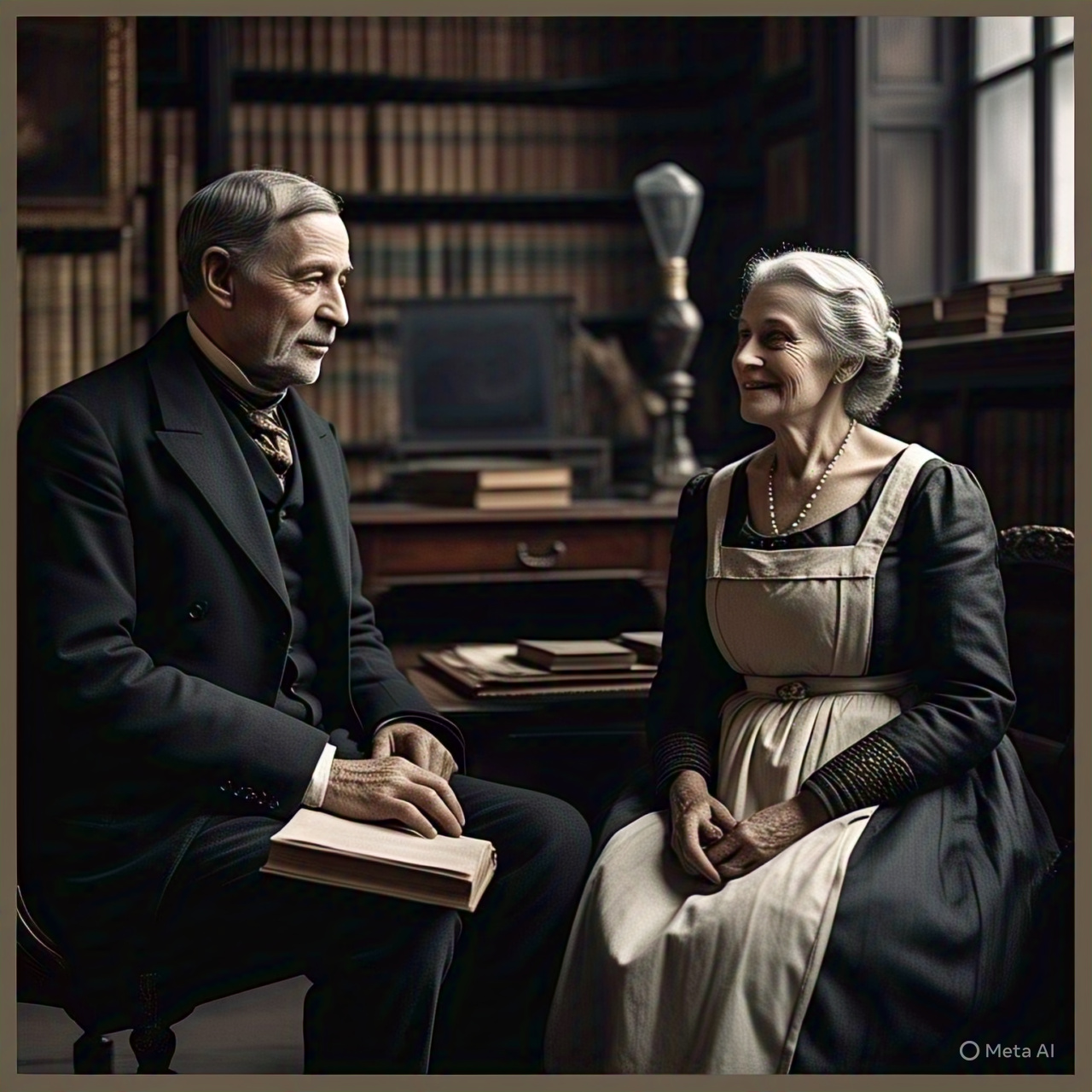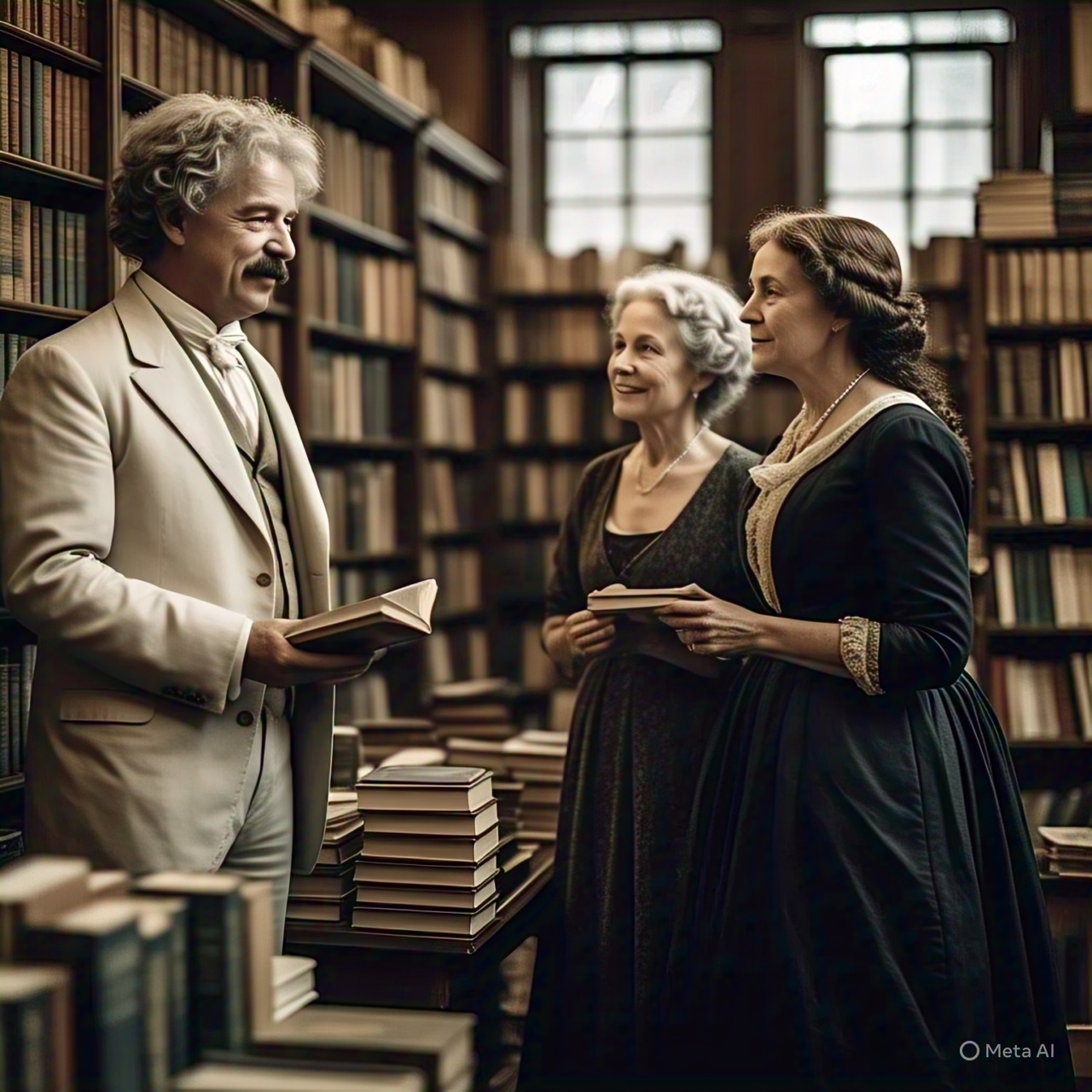Massachusetts 1866
If you are holding this curious volume in your hands, congratulations: you’ve stumbled upon something equal parts improbable and delightful. A sort of literary ghost story, minus the ectoplasm and plus a good deal more sarcasm.
Now, I’ll be the first to admit I never expected to be the man writing a foreword to a joint chronicle by Miss Jane Austen and Miss Charlotte Brontë—two women who, by rights, ought to have remained politely silent in the annals of history, given the dates printed next to their deaths. But history, like art, has a habit of misbehaving. And so, somehow, they are not only alive but living together in a snow-covered Massachusetts town, where the tea is strong, the grammar stronger, and the opinions stronger still.
Reading their pages, one quickly learns that Miss Austen’s wit can still slice the bark off a birch tree at ten paces, and Miss Brontë’s scowl can make a man forget his Christian name. What’s more, they are grappling with a strange and wonderful affliction: America. Or, more precisely, American-ness—the informal talk, the muddy roads, the unsettling cheerfulness of strangers, and the creeping infection of slang into the prose of very proper Englishwomen.
It is a rare thing to witness two minds of such caliber batting the world about like a shuttlecock. Rarer still when one of those minds begins to wonder aloud whether she’s begun to sound like me. I can assure you, gentle reader, that is both a compliment and a confession.
So here it is: the laughter, the quarrels, the long walks into town. A chronicle of cohabitation written in the margins of time. And if I’ve come off looking a bit foolish in the process—well, I had it coming.
Sincerely, Samuel Langhorne Clemens
Hartford, Connecticut, 1867
Back at the cottage, Jane and Charlotte read over Samuel’s introduction again, now bound at the front of the first galley proofs of their memoir. Charlotte made several scoffing noises, and Jane laughed until she had to set her tea down.
“He is either brilliant or completely irredeemable,” Charlotte declared.
“And you don’t think the two can coexist?”
Before Charlotte could answer, a knock rattled the front door.
Jane stood, smoothing her skirt. “I’m not expecting anyone.”
Charlotte followed her to the door, both curious and mildly alarmed.
When Jane opened it, a sharp-eyed man in a cravat and traveling cloak stood on their porch, half-snowed and entirely windblown.
“Ladies,” he said, with a courteous nod. “Forgive the intrusion, but I believe I’ve found exactly the ghosts I’m looking for.”
“Pardon?” Charlotte blinked.
“Wilkie Collins,” he said. “Author, traveler, enthusiast of the inexplicable. I read about English ghosts living in a Massachusetts village and thought: either this is a hoax or my next novel.”
Jane stepped aside, bemused. “Do come in, Mr. Collins.”
As he entered and shed his coat, he looked about the room like a detective at a crime scene. “Marvelous. You do look spectral in this lighting. Might I impose upon you for guidance? I’m planning a new mystery—working title, The Moonstone—and I confess I need a touch more… gothic.”
Charlotte narrowed her eyes. “You wrote The Woman in White.”
“Guilty.”
“It kept me awake.”
“Then I’m flattered.”
Jane gestured to the hearth. “Sit. Warm yourself. And tell us—what exactly did you hear about us in London?”
Collins grinned. “Only that Miss Austen had returned from the dead, and Miss Brontë had followed her across the Atlantic. I had to see if it was true.”
Charlotte muttered, “You could have written.”
“Where’s the suspense in that?”
They sat by the fire, a new kettle set to boil. Another voice, another pen, another improbable chapter in the strange, shared tale of authors who simply refused to stay buried.
As the fire crackled and Wilkie removed his gloves with a flourish, Jane rose from her chair.
“I’ll see to the tea,” she said, brushing her hands down the front of her apron. “Charlotte, do keep Mr. Collins company. Try not to haunt him.”
With that, she vanished into the kitchen, leaving the parlor in flickering warmth and curiosity.
Wilkie leaned forward with theatrical intensity. “Miss Brontë, I must tell you about The Moonstone. It concerns a cursed diamond, stolen from an Indian shrine and brought—foolishly—into an English country estate.”
Charlotte nodded slowly. “Stolen artifacts, colonial guilt, family secrets. A solid beginning.”
“Indeed,” Wilkie beamed. “There’s an opium addict. A puritan housemaid with a spiritual superiority complex. And a butler who loves Robinson Crusoe so dearly he consults it as a moral compass.”
Charlotte’s eyes widened, then narrowed. “That borders on parody.”
“Parody dances awfully close to truth, doesn’t it?”
She tilted her head. “Does the moonstone do anything? Glow? Whisper? Possess house pets?”
“No,” he said, almost proudly. “It just… is. Heavy with history. Still. Cold. A weight no one quite knows how to carry.”
Charlotte sat back, considering. “Then give it atmosphere. The house must creak. The portraits must leer. And for heaven’s sake, give someone a dream they can’t quite shake, one that smells faintly of sandalwood and guilt.”
Wilkie’s eyes lit up. “Yes, yes—exactly that. You see, Miss Brontë, I knew you’d understand.”
“And the diamond,” she added, tapping her teacup with one finger. “Don’t let it sit idle. Let it judge.”
Wilkie stared. “Let it… judge?”
“Like a ghost in mineral form.”
From the kitchen, Jane called, “That’s precisely the sort of sentence I’m going to carve into the biscuit tin.”
Charlotte turned toward the door. “We’re discussing literature, not refreshments!”
“And I,” Jane replied cheerily, “am saving you from putting a vengeful gemstone in someone’s porridge.”
Wilkie laughed heartily. “I must say, your domestic arrangement is far more haunted than I expected. I feel I’ve walked into a séance run by two schoolmistresses.”
Charlotte raised a brow. “We’re better than a séance. We finish the stories afterward.”
He nodded, solemn. “That’s the best kind of haunting.”
The kettle shrieked in the next room. Jane returned moments later with a tray of steaming cups, which she passed around like an officiant at some sacred rite.
And as the wind whispered around the corners of the little Massachusetts cottage, three literary souls sat sipping tea, plotting mysteries, and warming their hands by a fire that never quite went out.



